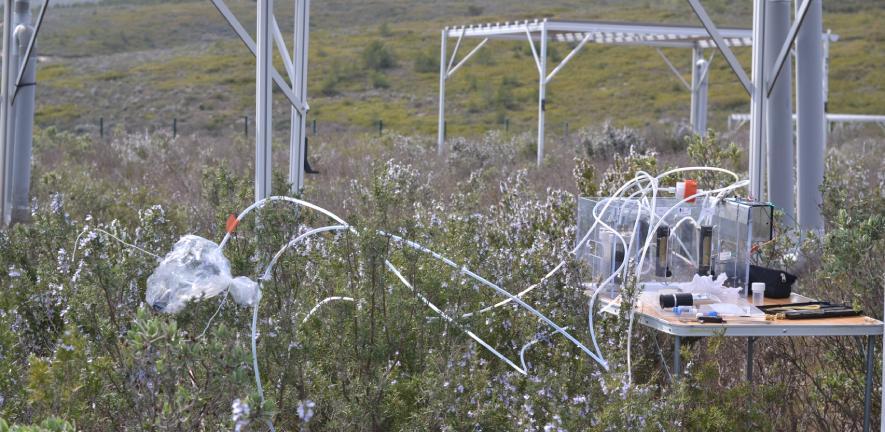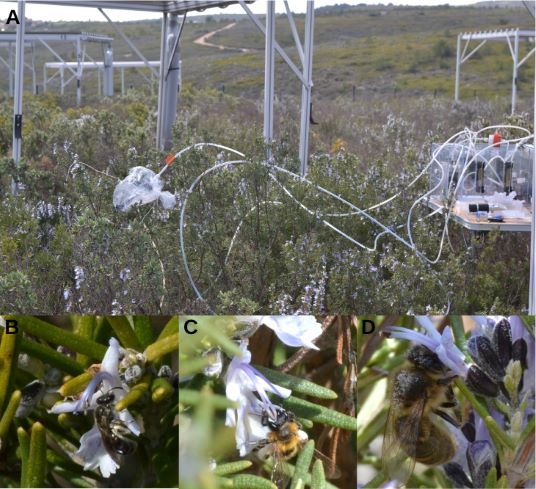
Submitted by Rachel Aucott on Mon, 08/08/2022 - 11:10
Pollination in a drier world: Even moderate drought alters floral scent
Climate change is everyday more present and dramatic in our everyday life, and 2022 has been no exception: heatwaves, drought, floods. Climate change also affects animals and plants, but more importantly it can have dramatic impacts on species interactions, which are the foundation of ecosystem functioning.
Pollination, a key ecosystem function necessary for the reproduction of many plants (and therefore, for the production of primary biomass) relies on pollinators’ capacity to locate flowers from their host plants in which they will collect floral resources (pollen and nectar). Pollinators such as bees use both visual cues (flower colour and size) and olfactory cues: floral scent.
Floral scent is a complex blend of dozens of volatiles and is very sensitive to environmental stress. Indeed, plant defence activation as a response to stress will cause the emissions of specific volatiles that mix up in floral scent.
Long-term drought experiment
In this study, we investigated how long-term drought, a major predicted change, affects floral scent and the consequences for plant-pollinator interactions. We used a long-term drought experiment equipped with rainfall exclusion plots in a natural Mediterranean plant community. We found a consistent alteration of floral scent in all species studied, with increased emissions of volatiles related to stress. This led to modifications of pollinator visits.
Changes to pollinator behaviour
Managed honeybees preferred to visit non-stressed plants, but their reduced visit frequency to drought-stressed plants was compensated by more visits by small wild bees. This suggests two potential processes:
- Bees make a choice between available floral resources, and recognise and decipher floral scent alterations to choose their preferred resource. Although we did not measure a difference, it is likely that floral resources may be affected by drought, for instance sugar content and composition in nectar may be modified.
- Floral resources are likely limited at the study site, possibly leading to some competition between bee functional groups. Managed honeybees were by far the most abundant pollinator on site, both by number of individuals and by number of visits. Because social bees like managed honeybees are adapted to track floral resources most efficiently, they might choose the best resources and outcompete social bees, which forage individually.
What are the effects on plant reproduction?
Despite the measured changes in pollinator visits, we measured limited impacts of drought on plant reproduction. This may be a consequence of the rather moderate drought (humid conditions) during the study. If even moderate climate change can alter plant-pollinator interactions, it is likely that the current climatic extreme events may have a profound impact on pollination and terrestrial ecosystem functioning.
Are there mitigation strategies?
We need more research to predict impacts of these drastic events, and to evidence possible mitigation strategies. Such strategies could be based on habitat diversification to increase microclimate diversity in ecosystems (eg, shaded areas) and floral resources diversification to fit a wider diversity of pollinator species throughout the year and a variety of weather conditions.
Written by Dr Coline Jaworski, Agroecology Group
Image: (A) Sampling of floral scent in the study site equipped with rainfall exclusion plots and control plots. (B,C) Two wild bee species of small body size and (D) Apis mellifera, the managed honeybee, which has a large body size, collecting floral resources on Salvia rosmarinus.
Paper: Jaworski, C.C., Geslin, B., Zakardjian, M., Lecareux, C., Caillault, P., Nève, G., Meunier, J.-Y., Dupouyet, S., Sweeney, A.C.T., Lewis, O.T., Dicks, L.V. and Fernandez, C. (2022), Long-term experimental drought alters floral scent and pollinator visits in a Mediterranean plant community despite overall limited impacts on plant phenotype and reproduction. J Ecol. Accepted Author Manuscript. https://doi.org/10.1111/1365-2745.13974

